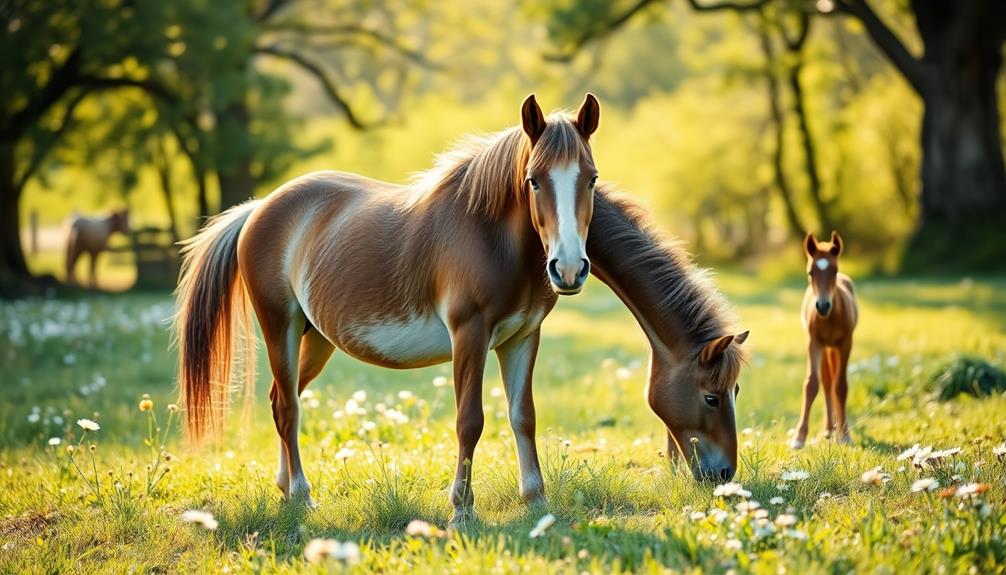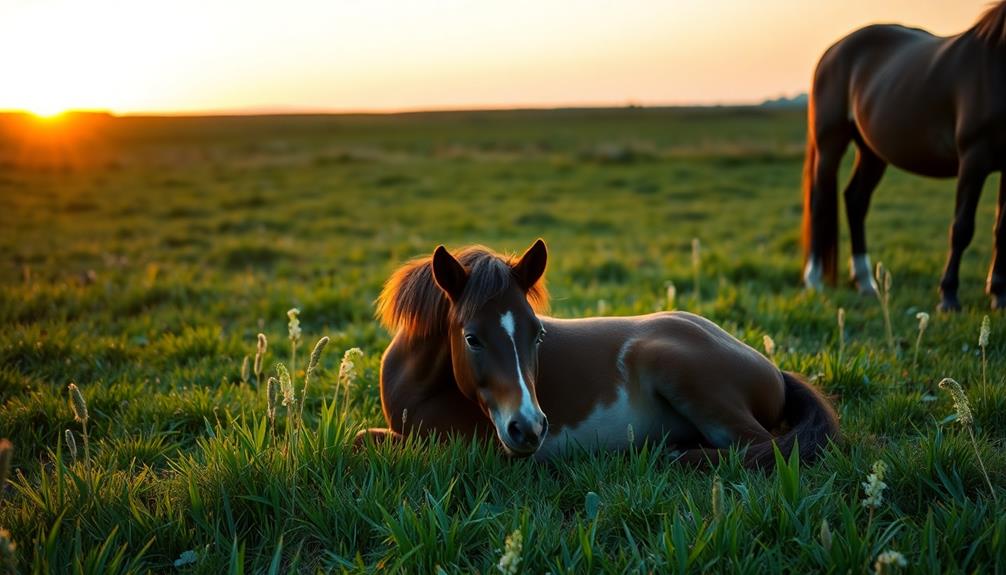Mini horses are usually pregnant for around 290 to 350 days, with an average gestation period of about 326 days. Some mares might foal as early as 300 days or as late as 365 days, depending on various factors like age and environment. You'll notice signs of pregnancy, such as weight gain and behavioral changes, as the months progress. Monitoring should ramp up around the 280-day mark to watch for foaling signs. Understanding these details can help you prepare better for the arrival of the foal and guarantee the mare's health during this important time. There's more to explore on this topic!
Key Takeaways
- Mini horse gestation lasts between 290 and 350 days, with an average of around 326 days.
- Some mares may foal as early as 300 days or as late as 365 days.
- Factors such as age, breeding history, and environment influence the length of gestation.
- Monitoring for foaling signs should begin around day 280 of gestation.
- Ultrasounds can confirm pregnancy as early as two weeks after breeding.
Understanding Mini Horse Gestation

Understanding Mini Horse Gestation is vital for any breeder or owner. Miniature horses typically experience a gestation length ranging from 290 to 350 days, with an average gestation of around 326 days.
It's important to recognize that some mares may foal as early as 300 days or as late as 365 days, highlighting the variability in gestation lengths among individual mares.
Factors influencing this duration include the mare's age, breeding history, environmental conditions, and the season during which breeding occurs.
To guarantee a smooth shift to motherhood, you should start monitoring for signs of impending foaling around day 280. Key indicators include udder development and noticeable behavioral changes that signal the mare is preparing to give birth.
Signs of Pregnancy in Mares

Recognizing the signs of pregnancy in mares is crucial for any owner or breeder. You'll want to look for several key indicators.
First, weight gain and abdominal enlargement are common physical signs of pregnancy. These changes usually become noticeable a few weeks after conception.
Behavioral changes in mares also play a significant role; you might notice your mare becoming more affectionate or, conversely, more isolated. It's crucial to monitor these shifts closely.
As the pregnancy progresses, the mammary gland will start to fill, and you may see wax formation on the teats. This typically indicates that your mare is nearing foaling.
For early confirmation of pregnancy, ultrasounds can be performed around two weeks post-breeding, offering you peace of mind.
Keep an eye out for increased rolling behavior, which might occur 1-2 weeks before foaling, signaling that delivery is imminent.
Stages of Mini Horse Pregnancy

After identifying the signs of pregnancy in mares, it's important to understand the various stages of mini horse pregnancy. The gestation period for miniature horses typically ranges from 290 to 350 days, with an average of about 326 days.
In the first trimester, you can confirm pregnancy through an ultrasound as early as two weeks post-breeding. By three months, identifiable features of the pregnancy become visible on ultrasound.
As the mare progresses into the second trimester, it's vital to start monitoring her nutrition, which should increase around the six-month mark.
When she approaches the last trimester, particularly around nine months, providing a comfortable and stress-free environment is significant for her well-being.
During the final weeks leading up to the due date, pay close attention to physical signs such as udder development and behavioral changes. These indicators signal that the foaling process is near.
Make certain you're prepared to monitor the mare for any complications, including the health of the umbilical cord and the overall condition of the foal. By staying vigilant, you can support your mare and facilitate a smoother change into motherhood.
Preparing for Foaling

Preparing for foaling requires careful attention and proactive measures to guarantee both the mare and foal's safety.
Start monitoring your miniature mares closely around day 280, but many breeders keep a keen eye on them by day 300. Look for signs of impending labor, like udder swelling and increased restlessness, along with prominent veins on the udder. These indicators can signal that foaling is approaching.
It's essential to create a foaling plan that addresses potential complications. This plan should include preparations for unexpected situations, ensuring you're ready for anything that might arise during delivery.
Regular vet check-ups leading up to the expected foaling date are important for monitoring your mare's health. Your vet can help assess readiness and provide guidance on any changes you should make in your preparations.
Utilizing urine tests, like Wee Foal 120, can also help confirm your mare's pregnancy status and readiness for foaling.
Post-Foaling Care and Monitoring

Post-foaling care is crucial for guaranteeing the health and wellbeing of both the mare and her newborn foal. Start by treating the foal's umbilical cord with iodine after it detaches to prevent infection.
You'll want to keep a close eye on the foal, monitoring it for signs of nursing. It's critical that the foal consumes colostrum within two hours, as this provides essential immunities.
Within the first 24 hours, verify the mare is wormed with paste Ivermectin, which helps prevent foal scours and supports her recovery.
Keep track of the foal's urination, as the first urination usually occurs around 8.5 hours post-birth. Monitoring urination frequency is important for checking the foal's health.
If the foal struggles to pass meconium within 24 hours, consider administering an enema to assist with this process.
Frequently Asked Questions
What Are Foaling Signs in Miniature Horses?
When you're observing a miniature horse about to foal, look for udder swelling, teat enlargement, wax formation, restlessness, and physical changes like sinking hips. These signs indicate that delivery is imminent. Keep a close watch!
How to Tell if Your Miniature Horse Is Pregnant?
Pregnancy pointers for your miniature horse include physical changes, like an expanding abdomen and udder, plus behavioral shifts such as increased affection or isolation. Regular vet checks help confirm and track her health throughout.
What Is the Gestation Timeline for Horses?
When considering a horse's gestation timeline, expect around 11 months, with variations. Track changes in behavior and physical signs starting around day 280 to prepare for the foal's arrival and guarantee proper care.
How Big Is a Foal at 7 Months Gestation?
At 7 months, a foal's like a budding flower, growing strong. It typically weighs 40 to 60 pounds and measures 20 to 24 inches long, showing signs of life and potential before entering the world.
Conclusion
To summarize, understanding mini horse gestation is key to ensuring a healthy pregnancy and foaling process. You'll want to keep an eye out for signs of pregnancy and prepare for the stages leading up to foaling. Remember, "An ounce of prevention is worth a pound of cure." By being proactive in your care, you can make the journey easier for both you and your mare, leading to a happy, healthy foal.










